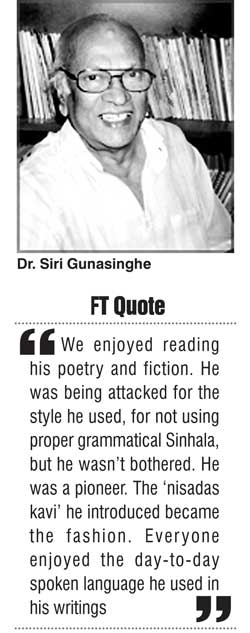Tuesday Dec 16, 2025
Tuesday Dec 16, 2025
Saturday, 10 June 2017 00:29 - - {{hitsCtrl.values.hits}}
He departed two weeks back. Media is still carrying tributes. A man who didn’t get due recognition for what he wrote, what he designed, what he drew is now being discussed in talk-shows over the electronic media and written about in both print and social media. All this about someone who has been living in Canada for the past nearly five decades paying an occasional visit to Sri Lanka. 
For Dr. Siri Gunasinghe it was a long journey for 92 years. I was fortunate getting to know the simple, unassuming, friendly young lecturer from my days in the Peradeniya campus in the early 1950s. I am happy I was able to recall my association with him two years ago through this column when he reached 90.
I didn’t know his wife Hemamali (she was junior to us at Peradeniya), but was a close friend of her brother, Anura. He and I attended a mass communication seminar way back in 1971 in Seoul – both of us were possibly among the earliest Sri Lankans to visit South Korea.

We enjoyed reading his poetry and fiction. He was being attacked for the style he used, for not using proper grammatical Sinhala, but he wasn’t bothered. He was a pioneer. The ‘nisadas kavi’ he introduced became the fashion. Everyone enjoyed the day-to-day spoken language he used in his writings.
His stage décor in ‘Maname ’was not being talked about. But many started adopting modest décor. The costumes he designed in several dramas in the late 1950s were not commented on. So were the simple book covers. (Incidentally, the cover of his last novel, ‘Miriguva Alleema’ (2002), was designed by his son, Ravi.)
When he made ‘Sath Samudura’, everyone took note of him. He knew young Nihalsingha’s capabilities to lend him a hand in the technical field. He was not afraid to give a place to newcomers. Swarna Mallawaarachchi possibly reaped the most from her maiden role in the film. She recently confessed that having seen the advertisement calling for actresses, she went there just to see him because she had liked his writings and got selected. “A great mind and a great human being,” was how she paid tribute after his death.
One of the best examples of Siri Gunasinghe’s approach to controversial issues was when he invited Dr. J.B. Disanayaka for the launch of his novel ‘Miriguva Alleema’. S.G. strongly believed that there should not be a distinction between the spoken and written Sinhala. Write the way we talk, he insisted. To J.B. it was different. When we write, we should use a prim and proper style, what is normally called classical Sinhala. We should not ignore grammar.
J.B. elaborated: What is being written should be distinctly different from the spoken word. Using the spoken language in dialogues within a novel can be accepted, but not for the rest. The sentences should be properly structured and grammatical usage should be followed.
S.G. didn’t really agree. He explained his approach. While not accepting that the written language should be different, he said creative literature should be written in the way it is spoken. We should get out of the rigid grammatical form of writing. However, there may be words which sound classical, yet accepted in common usage. Such words he had used in the same form in his book.
J.B., however, saluted S.G. for the bold stand he takes in whatever he handles. He created a stir with his maiden work, ‘Mas Le Nethi Eta’, the controversial anthology of blank verse he produced. So was his first novel, ‘Hewanella’.

When he made his one and only feature film, ‘Sath Samudura’, it was something different. He had an old favourite ‘Padmawathi’ in the film and composed ‘Somawathi’ in the same style for a documentary he made. There was a fresh approach when he designed the stage settings and costumes in ‘Maname’.
J.B. also reminded the audience that S.G. was responsible for pioneering studies on the masks of Sri Lanka and Buddhist paintings in the Kandyan period. He also mentioned the French work, ‘La technique de la peinture indienne’ done during his Sorbonne days.
I picked the above comments from the ‘Kala Korner’ column I wrote in the Sunday Times way back in April 2002.